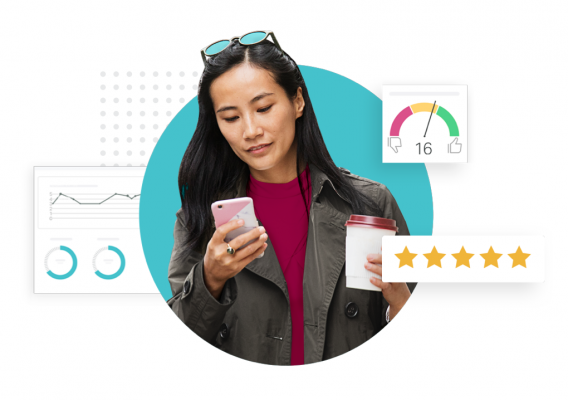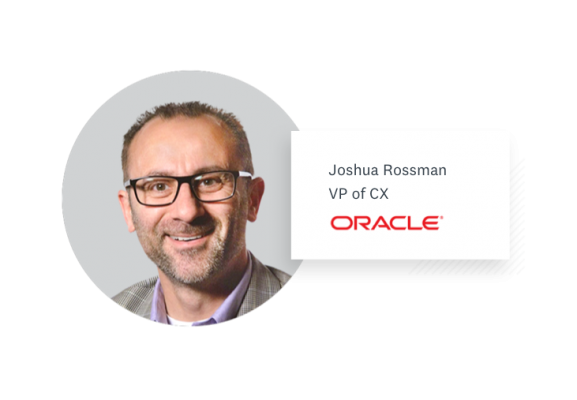On-demand learning experience: Driving a successful CX program with Oracle’s Joshua Rossman

More than two-thirds of companies compete primarily on customer experience (CX). To do that, the first and arguably most important step is to understand it. When businesses pour resources into new dedicated CX functions, they’re really investing in insights they can use to improve and differentiate themselves.
But CX is complicated—it spans the entire customer journey and encompasses everything from product to customer service to brand. You need to understand how customers feel, why they feel that way, how important it is to them, and what might change their perspective.
Oracle’s Joshua Rossman, VP of Customer Experience, has spent over 15 years working to solve those problems at companies like Microsoft, Mcafee, and eBay. He’s also an advisor to over 30 different startups of all different sizes. Momentive (maker of SurveyMonkey) partnered with Joshua on a 3-part expert class in building an effective CX strategy.
Meet your professor: Joshua Rossman

Joshua Rossman, VP of CX at Oracle
Joshua Rossman knows what it takes to understand your customers.
In addition to leading CX at Oracle, Josh has worked in customer experience for almost as long as the function has existed (~20 years). He's an advisor to dozens of startups, and has also worked at industry-leading companies like McAfee, eBay, and Microsoft. He's a recognized expert in deploying Net Promoter Systems and building Customer Experience (CX) teams.
Josh has worked with a variety of organizations and in a variety of roles, touching everything from analytics to culture-building. His principles of CX apply to everyone and are deeply thought through and broadly tested.
At Oracle, he collects customer feedback, distills it into actionable insights, and implements change across the organization. The on-demand learning experience draws on each of those skillsets.

Align: Getting your feedback systems in place
Feedback is the foundation of customer experience strategy. You need clean, comprehensive data streams to make effective CX decisions. Information about the current “state of affairs” is as important for the leader of a CX team as it is for an individual practitioner—and vice versa.
In this video, Josh delves into his own personal experience as a CX leader at tech companies like eBay and McAfee to explain how to launch a CX program and which pitfalls to avoid. We start with the big ideas, like how to align on priorities with cross-functional stakeholders, then get into specifics like exactly which questions to put in your NPS®* surveys. Watch the video all at once, or skip to the questions you care about.
Video to cover:
- Defining the role of the CX function and who to hire for your team
- Choosing the right goals and managing resources internally
- Mapping the customer experience
- Survey architecture and the perfect NPS survey
- Survey sampling strategy— triggers, parameters, incentives
Exercise: internal stakeholder alignment
Customer experience spans across product, customer support, marketing, and beyond, which makes aligning on goals and priorities essential for success. CX teams should meet with stakeholders at a regular cadence—weekly, monthly, or quarterly—to ensure their insights are always maximally valuable. This worksheet is designed to help guide that conversation.
Is your product team contemplating changing something about your product? Is your marketing team hungry for customer stories with a certain use case? Needs and opportunities are always changing. If you have a SurveyMonkey account, you can use this template gather input in a central location and keep it documented.
You can change and customize the questions to be relevant to your specific needs. We recommend scheduling the survey to send automatically to stakeholders a few days before each check in to give them time to fill it out.
Additional resources
Technical spotlight: connecting SurveyMonkey + B2B Service Cloud for automated surveys
You can connect SurveyMonkey with Oracle’s B2B Service cloud to automatically initiate surveys based on service requests. You’ll be able to create customized decision models based on customer information to trigger surveys at key times and enrich response data.
You can use expert-designed SurveyMonkey templates or create your own surveys to track customer satisfaction after a service engagement.
You need both a B2B Service Cloud account and a SurveyMonkey account to access the integration. Learn more here.
Shape better customer experiences with Momentive
Try one of our AI-powered solutions designed to help gather and act on customer feedback with speed and agility.
Analyze: making sense of your data
The second stage of understanding customer experience involves distilling “feedback” into “insights.” Often, it’s easier said than done.
This section discusses the false conclusions that many CX teams fall into and how to avoid them, as well as best practices for packaging and sharing your findings. Analytics hygiene starts in the survey stage, but it’s not just accuracy you’re looking for—it’s actionability.
Here’s how you and your team can think about both as your CX program matures.
Video to cover:
- Common pitfalls in customer feedback analysis (with real-life examples)
- Analysis techniques
- Putting findings into broader context
- Prioritizing the right findings
- Best ways to share and present survey results
Exercise: root cause analysis checklist
It's tempting to let your results speak for themselves, but even the most seasoned CX leaders can overlook something important when they share feedback too quickly. Before you draw conclusions based on customer feedback, give yourself as many layers of context as you can. by running through this checklist.
1. Consider the source. Is your feedback coming from a particular type of survey (e.g. a check-in survey triggered from a customer interaction)? Would that source be skewed at all? Many times, the types of people who fill out a survey skew toward the extremes (people who love or hate your company), so their responses might not represent the majority.
2. Look at demographics. Filter your responses to find trends based on geography, demographics, or how they answered a certain question.
3. Combine survey data with other customer data. If you can, cross-reference survey results with information you already have about the customer to find trends. You can also automate this through
integrations. This can help you understand whether there are correlations between survey responses and product used, tenure as a customer, etc.
4. Check the timing against major events. Major product updates and news coverage of your company can have a meaningful impact on satisfaction ratings. World events can have an influence as well—it might be worth a cursory search if you think your audience might have been influenced.
5. Reread the exact phrasing of your questions. Sometimes this can skew the results. Is there any way those questions could have been misinterpreted? This can be especially important when reviewing responses to open-ended questions.
6. Make a rubric for impact vs, consistency. As Josh points out in the video, just because feedback comes up more frequently doesn't mean that it matters more. A small irritant that affects many customers needs to be addressed, but not as urgently as a dealbreaker that affects fewer people. If you aren't sure how important something is, gather more feedback before you present your results.
Additional resources
Technical spotlight: using SurveyMonkey + Oracle Eloqua for personalized customer care
Using SurveyMonkey + Oracle’s Eloqua enables you to marry customer feedback with other customer data like job role, products purchased, and renewal history. This gives you context in 2 ways—you can interpret the feedback you get according to that person’s role or history with your company, and you can also enrich the Eloqua customer profile with survey responses.
When the data is integrated, you can segment your customers into subgroups and create personalized strategies for interacting with each. As Joshua covers in the video, common segmentations include NPS status (promoter/detractor), geography, product use case, or customer histories—but you can choose what makes sense for your company based on your goals.
Eventually, integrating these systems can also help you automate certain parts of customer care—like triggering immediate follow-up actions when a customer fills out a survey. You can learn more about using SurveyMonkey and Oracle Eloqua together here.
Momentive solutions offer a holistic approach to CX
Try one of our AI-powered solutions designed to help decision-makers make key strategic choices, quickly and confidently.
Act: Putting your CX insights to work
When you’ve collected ample feedback and analyzed the responses, it’s time to catalyze that feedback into positive change. This stage of a CX program tends to be the least clear and the area where CX professionals might feel that they have the least control.
In this section, Josh explains where CX teams have the most opportunity to make an impact—through culture building and creating accountability for acting on customer feedback. Often, small, effortless investments can make a major difference in customer centricity.
Video to cover:
- Why leadership needs to be involved in the customer cause
- How to amplify the voice of the customer internally
- Making CX an organizational priority
- Processes for holding stakeholders accountable
- Tracking progress over time
Exercise: Customer interaction reports
Customer experience isn’t limited to just people who have those words in their title. It’s an organization-wide effort. This exercise is intended to get the community actively involved and leverage them to get customer stories front and center.
Customer interaction reports (CIRs) are 5-minute surveys (or worksheets) that employees fill out after any engagement with a customer—whether it’s a service rep addressing a challenge, a marketer talking to strangers, or a social media intern sifting through delighted tweets. Those responses are then shared on a platform of your choice.
This survey template includes generic versions of the questions that we use at SurveyMonkey and recommend, but you can customize it or build your own. It’s a lightweight thing to implement but can be incredibly impactful. You can share the responses:
- At the beginning of town halls and other major meetings
- In a dedicated Slack channel (which can be automated) or messaging board
- On a company intranet or other resource
- On TVs and other office displays
- At off-sites and dedicated team meetings
CIRs can be a one time requirement or an ongoing program. They can be incentivized with rewards or mandated. The end goal either way should be to inspire—constructive improvement, employee enthusiasm, or even future marketing. Experiment with different models or questions or questions over time to get the most value.
You can follow step-by-step instructions for building a CIR program here.
Additional resources
Technical spotlight: personalized marketing campaigns through SurveyMonkey and Eloqua
Part of customer experience involves getting people resources that can help them—without bothering them about the things they don’t want. It’s a sensitive balance, and the more data you have, the better prepared you’ll be to serve them correctly.
After you’ve segmented your responses in Eloqua, you can craft personalized relationships with each customer. Reach out to them for future feedback, share personalized marketing campaigns, or provide them with helpful resources based on their responses.
You can learn more about using SurveyMonkey and Oracle Eloqua together here.
The better you understand customer experience, the more effectively you'll be able to shape it. We hope that you and your team benefitted from Joshua's expertise and were able to build helpful, sustainable programs based on his insights.
*Net Promoter, Net Promoter Score, and NPS are trademarks of Satmetrix Systems, Inc., Bain & Company, Inc., and Fred Reichheld.
Discover more resources

Toolkits directory
Discover our toolkits, designed to help you leverage feedback in your role or industry.

How to make your data collection more secure

Boost survey response rates with these 20 email templates
Enhance your survey response rates with 20 free email templates. Engage your audience and gather valuable insights with these customizable options!

P-value calculator: How to calculate p-value
Leverage our p-value calculator to find your p-value. Plus, learn how to calculate p-value and how to interpret p-values with our step-by-step guide.








